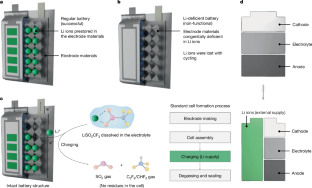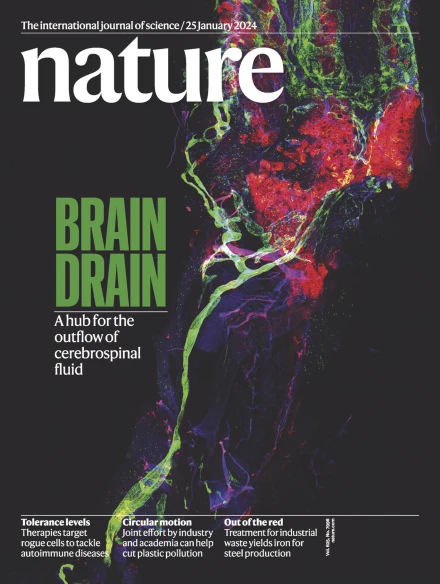External Li supply reshapes Li deficiency and lifetime limit of batteries
IF 50.5
1区 综合性期刊
Q1 MULTIDISCIPLINARY SCIENCES
引用次数: 0
Abstract
Lithium (Li) ions are central to the energy storing functionality of rechargeable batteries1. Present technology relies on sophisticated Li-inclusive electrode materials to provide Li ions and exactingly protect them to ensure a decent lifetime2. Li-deficient materials are thus excluded from battery design, and the battery fails when active Li ions are consumed3. Our study breaks this limit by means of a cell-level Li supply strategy. This involves externally adding an organic Li salt into an assembled cell, which decomposes during cell formation, liberating Li ions and expelling organic ligands as gases. This non-invasive and rapid process preserves cell integrity without necessitating disassembly. We leveraged machine learning to discover such functional salts and identified lithium trifluoromethanesulfinate (LiSO2CF3) with optimal electrochemical activity, potential, product formation, electrolyte solubility and specific capacity. As a proof-of-concept, we demonstrated a 3.0 V, 1,192 Wh kg−1 Li-free cathode, chromium oxide, in the anode-less cell, as well as an organic sulfurized polyacrylonitrile cathode incorporated in a 388 Wh kg−1 pouch cell with a 440-cycle life. These systems exhibit improved energy density, enhanced sustainability and reduced cost compared with conventional Li-ion batteries. Furthermore, the lifetime of commercial LiFePO4 batteries was extended by at least an order of magnitude. With repeated external Li supplies, a commercial graphite|LiFePO4 cell displayed a capacity retention of 96.0% after 11,818 cycles. A strategy is reported that improves the performance and lifetime of lithium-ion batteries by adding organic Li salt after assembly, which decomposes during cell formation, liberating Li ions and expelling organic ligands as gases.


外置锂电源改变了电池的锂不足和寿命限制
锂离子是可充电电池储能功能的核心。目前的技术依赖于复杂的含锂电极材料来提供锂离子,并精确地保护它们,以确保良好的使用寿命2。因此,锂缺乏材料被排除在电池设计之外,当活性锂离子被消耗时,电池就会失效。我们的研究通过细胞级锂供应策略打破了这一限制。这包括在外部将有机锂盐添加到组装的细胞中,在细胞形成过程中分解,释放锂离子并以气体形式排出有机配体。这种非侵入性和快速的过程保持了细胞的完整性,而无需拆卸。我们利用机器学习来发现这些功能盐,并确定了具有最佳电化学活性、电势、产物形成、电解质溶解度和比容量的三氟甲烷磺酸锂(LiSO2CF3)。作为概念验证,我们在无阳极电池中展示了3.0 V, 1,192 Wh kg - 1的无锂阴极,氧化铬,以及在388 Wh kg - 1的袋式电池中集成的有机硫化聚丙烯腈阴极,具有440循环寿命。与传统锂离子电池相比,这些系统具有更高的能量密度、更强的可持续性和更低的成本。此外,商用LiFePO4电池的寿命至少延长了一个数量级。在重复的外部锂供应下,商用石墨|LiFePO4电池在11818次循环后的容量保持率为96.0%。
本文章由计算机程序翻译,如有差异,请以英文原文为准。
求助全文
约1分钟内获得全文
求助全文
来源期刊

Nature
综合性期刊-综合性期刊
CiteScore
90.00
自引率
1.20%
发文量
3652
审稿时长
3 months
期刊介绍:
Nature is a prestigious international journal that publishes peer-reviewed research in various scientific and technological fields. The selection of articles is based on criteria such as originality, importance, interdisciplinary relevance, timeliness, accessibility, elegance, and surprising conclusions. In addition to showcasing significant scientific advances, Nature delivers rapid, authoritative, insightful news, and interpretation of current and upcoming trends impacting science, scientists, and the broader public. The journal serves a dual purpose: firstly, to promptly share noteworthy scientific advances and foster discussions among scientists, and secondly, to ensure the swift dissemination of scientific results globally, emphasizing their significance for knowledge, culture, and daily life.
 求助内容:
求助内容: 应助结果提醒方式:
应助结果提醒方式:


